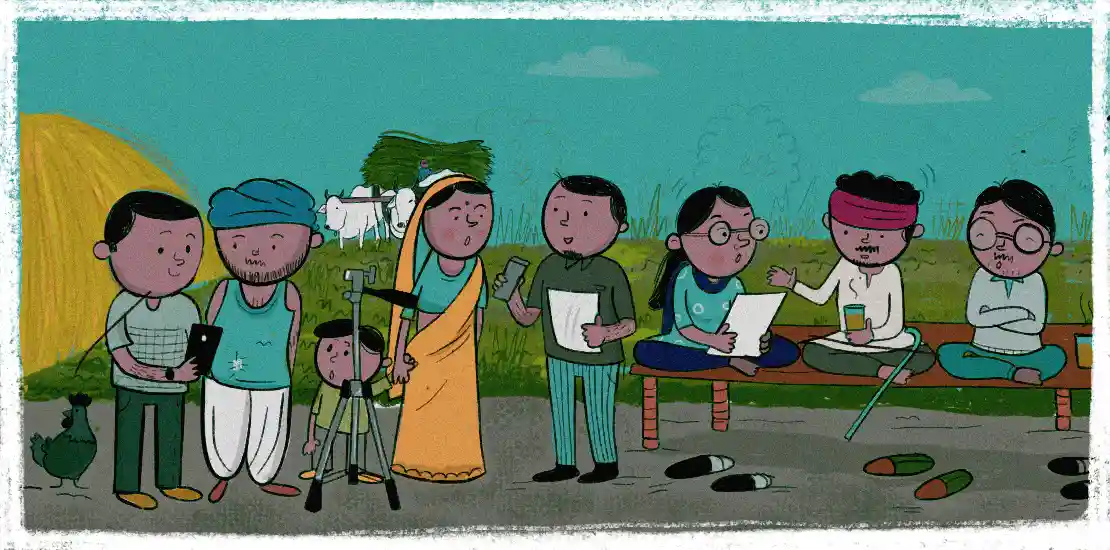UX UI Design Studio


Not too long ago, I was given the opportunity to work on a challenging, yet extremely interesting project that was aimed at empowering Indian farmers: An app that focuses on creating a knowledge portal, as well as a connected marketplace for all the players in the ecosystem. We were involved in the experience design of the app, and I personally led the research wing for it.
Taking the scope of the mAgri project, as well as the user group into consideration, the Lollypop team conducted Ethnographic Research, such as user interviews and observational research techniques with 150+ farmers over a period of 3 months in several villages of Karnataka and Maharashtra.
We at Lollypop firmly believe that facts precede assumptions when designing a digital experience– and only research can help create solutions for the most complex problems, which in this case is Agritech. This, in turn, led us to delve deeper into understanding our target audience. I’ve shared some crucial learnings and insights in the process below.
Understanding an Indian farmer’s psyche was surely a tedious task, as they are quite an unconventional audience— the underlying reason being the disparity in the thought process due to an unequal distribution of resources. Below, I have listed a few fundamental challenges that every designer or concerned entrepreneur may face during the ideation phase:
It is important to know that during the brief provided by the client all we knew was that we needed to create a digital platform that empowers and enable farmers with the right information and resources. But, the scope of the study was unknown, and it was left to us to devise a digital solution that could onboard and solved the fundamental pain points of our users. What follows are the learnings we think are fundamental for every designer or Agritech entrepreneur.
Since this research was exploratory in nature, it was necessary to carry out some web-based preliminary research on farmers and the agricultural scenario in India before diving straight into the field. We went through case studies, reports, and different kinds of research papers to know what are the most pressing problems and needs of Indian farmers.
The learnings helped me narrow down my research goals and aided the interview process. This project clarified the importance of desk research– every case study, report, and research paper I read helped me gain a better understanding of the agriculture domain, and attuned me to adopt an appropriate methodology for the research process.
Goals and objectives should be the driving force for every question asked in an interview. The more specific the objectives, the easier it is to create questions and extract the appropriate answers for analysis.
In this research project, the interviews were carried out in order to understand the farmers’ day-to-day activities, the processes they implement, crop cycles they undergo, and the cognitive factors that contribute to their decision-making processes. The expected outcome of the interview was to narrow down the target audience, gain an understanding of farming, and discreetly identify the critical decisions a farmer needs to make for sustainable, profitable yield. This step helped us lay a strong design foundation.
At first, the Lollypop team decided to conduct one-on-one interviews with the farmers, as these kinds of interviews provided a lot more behavioural data and insights. We also aimed at doing semi-structured interviews on the field, so that natural conversations and new ideas could be brought up during the interview.
However, we realized that one-on-one interview was not the best option, as most of the time, farmers were found in groups— and even when we did try to interview them individually, their fellow farmers constantly jumped in to add their bit to the conversation. Additionally, since we were recording these interviews on video, a rolling camera made the other farmers curious, which eventually led them all to gather around and watch the show. Hence, we changed our methodology and went on with focus-group interviews.
The lesson learnt was the importance of being flexible and the ability to adapt ourselves on the spot to the situation accordingly, without compromising the data quality and the collection process– something that is of utmost necessity. Many unforeseen circumstances such as environmental factors or social and psychological factors like community constraints and fear of opening up to an unknown audience may pose a great challenge. And so, one should always be ready to improvise.
It’s vital not to trim the questions in the first bit itself- one needs to go onto the field and then begin to prioritize based on the situations. We had an exhaustive list of 50-60 questions that were grouped into various sections based on the preliminary research and the goals of the interview.
We formulated a few closed-ended questions to get specific answers, as we wanted to run a statistical test to validate our findings. Moreover, it also provided valuable information to the clients for business decisions. For instance, we asked them questions like, “How much of your land is dedicated to farming?” and “How many crops do you grow per year?”. We believe that when it comes to any kind of research, it’s important to try and obtain both, qualitative, as well as quantitative data, especially, when you have a large sample size at your disposal.
When it comes to researching a user group that speaks a different language from the one you do, it’s important to be thorough– things are easily lost in translation, which is why it’s necessary to provide translators with an exhaustive brief prior to research itself, and also make sure the questions styled aren’t convoluted.
Every project, however ambitious, needs to have a timeline attached to it and need to see the light– we need to adopt the iterative process and keep improvising, but for that, we need to hit the market first. Hence, after finalizing the overall research plan we estimated a timeline of two months, however, the research stretched to three months. Post the initial research, a set of 50-60 questions were at hand, and during the first few sessions, a good 40-50 minutes were spent.
However, we soon realized that it was hard to keep the user engaged for such a long time. Given the timeline, we prioritized a few questions and added ones that popped up during our sessions. And so, at any point of time, we as designers should hold responsibility and not lose sight of the final goal and attune ourselves to the given time frame.
We faced two difficulties: first, aligning ourselves to farming jargons and second, making our user base comfortable. For the first challenge, we involved our clients so that they could provide us with a domain expert individual to help sail us through, and for the second challenge, we started developing a trust-based relationship by being genuinely interested in their everyday lives. Asking the users questions about their daily lives, routine, and more, allowed them to open up. This, in turn, helped us obtain better and useful responses from the farmers.
The learnings on this particular project were innumerable, but one fundamental take away for everyone was that research not only provides the insights to derive the solutions to problem statements. It also guides us through the project feasibility and viability. It basically guides all the stakeholders in a better and improvised direction to accomplish something that is truly worthwhile. In our case it was empowering and marginalizing the livelihood of over 50% population of India, shoulder we all survive on.
